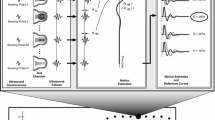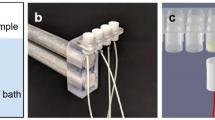Abstract
Inappropriate blood coagulation plays a central role in the onset of myocardial infarction, stroke, pulmonary embolism, and other thrombotic disorders. The ability to screen for an increased propensity to clot could prevent the onset of such events by appropriately identifying those at risk and enabling prophylactic treatment. Similarly, the ability to characterize the mechanical properties of clots in vivo might improve patient outcomes by better informing treatment strategies. We have developed a technique called sonorheometry. Unlike existing methods, sonorheometry is able to assess mechanical properties of coagulation with minimal disturbance to the delicate structure of a forming thrombus. Sonorheometry uses acoustic radiation force to produce small, localized displacements within the sample. Time delay estimation is performed on returned ultrasound echoes to determine sample deformation. Mechanical modeling and parametric fitting to experimental data yield maps of mechanical properties. Sonorheometry is well suited to both in vitro and in vivo applications. A control experiment was performed to verify that sonorheometry provides mechanical characterization in agreement with that from a conventional rheometer. We also examined thrombosis in blood samples taken from four subjects. This data suggests that sonorheometry may offer a novel and valuable method for assessing the thrombogenicity of blood samples.
Similar content being viewed by others
REFERENCES
Anderson, F. A., and A.-M. Audet. Best Practices: Preventing Deep Vein Thrombosis and Pulmonary Embolism. Center for Outcomes Research, U MassMed Center, 1998.
Emelianov, S. Y., J. M. Rubin, X. Chen, A. R. Skovoroda, T. W. Wakefield, and M. O'Donnell. Ultrasound elasticity imaging of deep vein thrombosis. Proc. IEEE Ultrason. Symp. 1791-1794, 2000.
Harris, J. M., and N. Abramson. Evaluation of recurrent thrombosis and hypercoagulability. Am. Fam. Physician 56, Oct. 15, 1997.
Hartley, C. J. Characteristics of acoustic streaming created and measured by pulsed Doppler ultrasound. IEEE Trans. Ultrason., Ferroelectrics, Frequency Control 44:1278–1285, 1997.
Hirsch, J., and J. Hoak. Management of deep vein thrombosis and pulmonary embolism. A statement for healthcare professionals. Council of Thrombosis, American Heart Association. Circulation 93:2212–2245, 1996.
Hirsh, J., and A. Y. Lee. How we diagnose and treat deep vein thrombosis. Blood 99:3102–3110.
Jensen, J. A., and N. B. Svendsen. Calculation of pressure fields from arbitrarily shaped, apodized, and excited ultrasound transducers. IEEE Trans. Ultrason., Ferroelectrics, Frequency Control 39:262–267, 1992.
Nightingale, K. R., R. Nightingale, D. Stutz, and G. E. Trahey. Acoustic radiation force impulse imaging of in vivo vastus medialis muscle under varying isometric load. Ultrason. Imaging 24:100–108, 2002.
Nightingale, K. R., M. S. Soo, R. Nightingale, R. Bentley, and G. E. Trahey. In vivo demonstration of acoustic radiation force impulse (ARFI) imaging in the thyroid, abdomen, and breast. Proc. IEEE Ultrason. Symp. 1627–1631, 2002.
Nightingale, K. R., M. S. Soo, R. Nightingale, and G. E. Trahey. Acoustic radiation force impulse imaging: In vivo demonstration of clinical feasibility. Ultrasound Med. Biol. 28:227–235, 2002.
Parsons, R. E., B. Sigel, E. J. Feleppa, R. M. Golub, I. Kodama, L. A. Loiacono, J. Justin, V. K. Swami, H. Kimitsuki, M. Rorke, M. M. Yaremko, C. D. Long, A. Can, and F. L. Lizzi. Age determination of experimental venous thrombi by ultrasonic tissue characterization. J. Vasc. Surg. 17:470–478, 1993.
Shung, K. K., D. Fei, Y. Yuan, and W. C. Reeves. Ultrasonic characterization of blood during coagulation. J. Clin. Ultrasound 12:147–153, 1984.
Viola, F., and W. F. Walker. A comparison of the performance of time delay estimators in medical ultrasound. IEEE Trans. Ultrason., Ferroelectrics, Frequency Control 50:392–401, 2003.
Viola, F., and W. F. Walker. Radiation force imaging of viscoelastic properties with reduced artifacts. IEEE Trans. Ultrason., Ferroelectrics, Frequency Control 50:736–742, 2003.
Visit the following link for a list of tests commonly performed by laboratories: http://repro-med.net/papers/thromb.html
Walker, W. F., F. J. Fernandez, and L. A. Negron. A method of imaging viscoelastic parameters with acoustic radiation force. Phys. Med. Biol. 45:1437–1447, 2000.
Webster, J. G. Medical Instrumentation: Application and Design. New York: Wiley, 1998, p. 33.
Author information
Authors and Affiliations
Rights and permissions
About this article
Cite this article
Viola, F., Kramer, M.D., Lawrence, M.B. et al. Sonorheometry: A Noncontact Method for the Dynamic Assessment of Thrombosis. Annals of Biomedical Engineering 32, 696–705 (2004). https://doi.org/10.1023/B:ABME.0000030235.72255.df
Issue Date:
DOI: https://doi.org/10.1023/B:ABME.0000030235.72255.df




